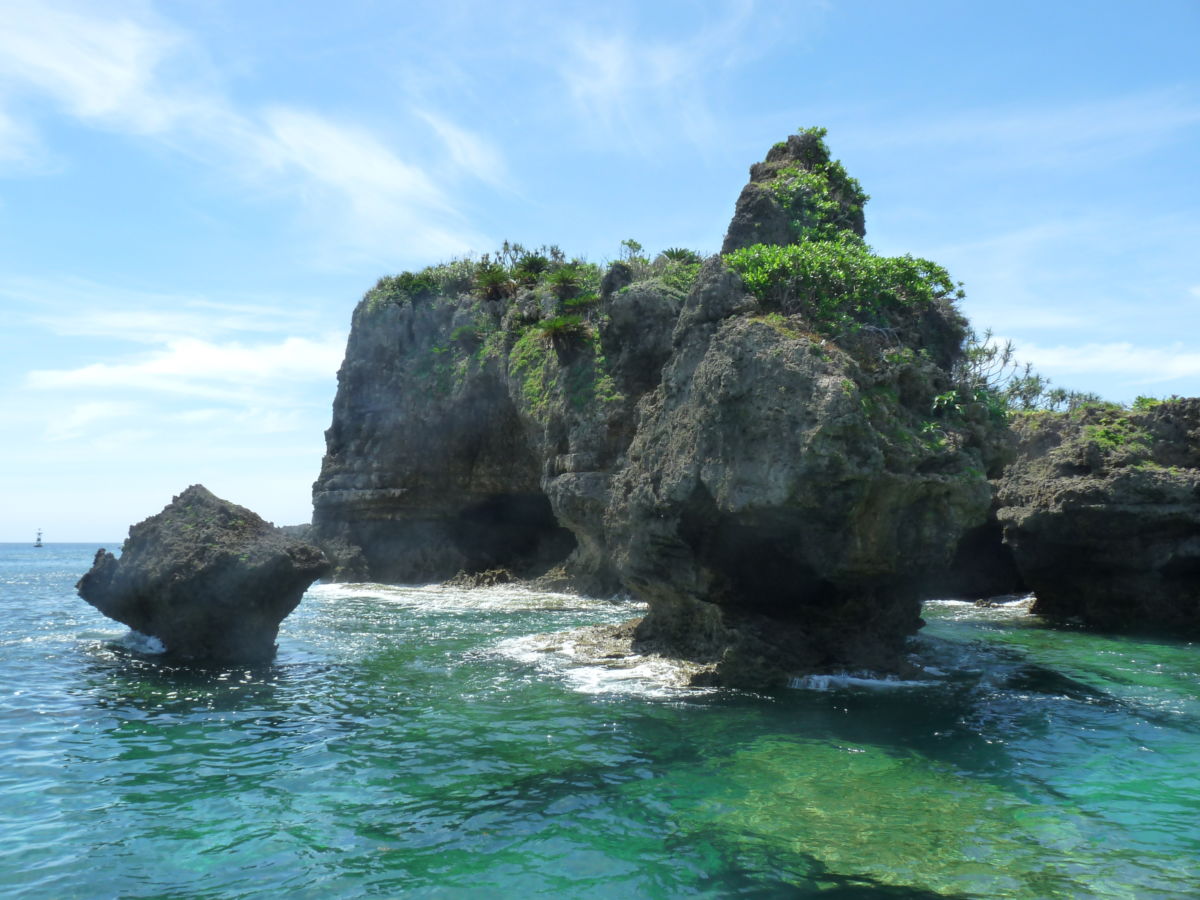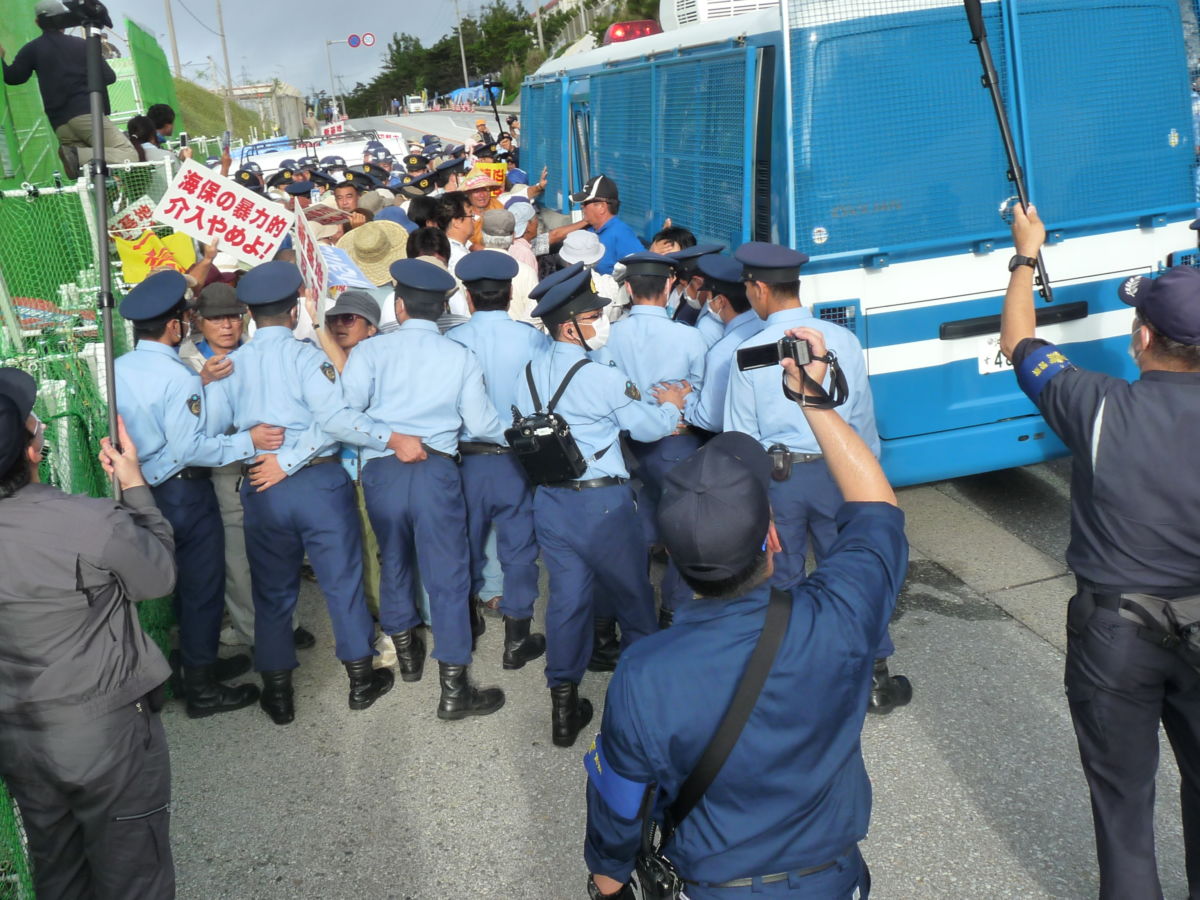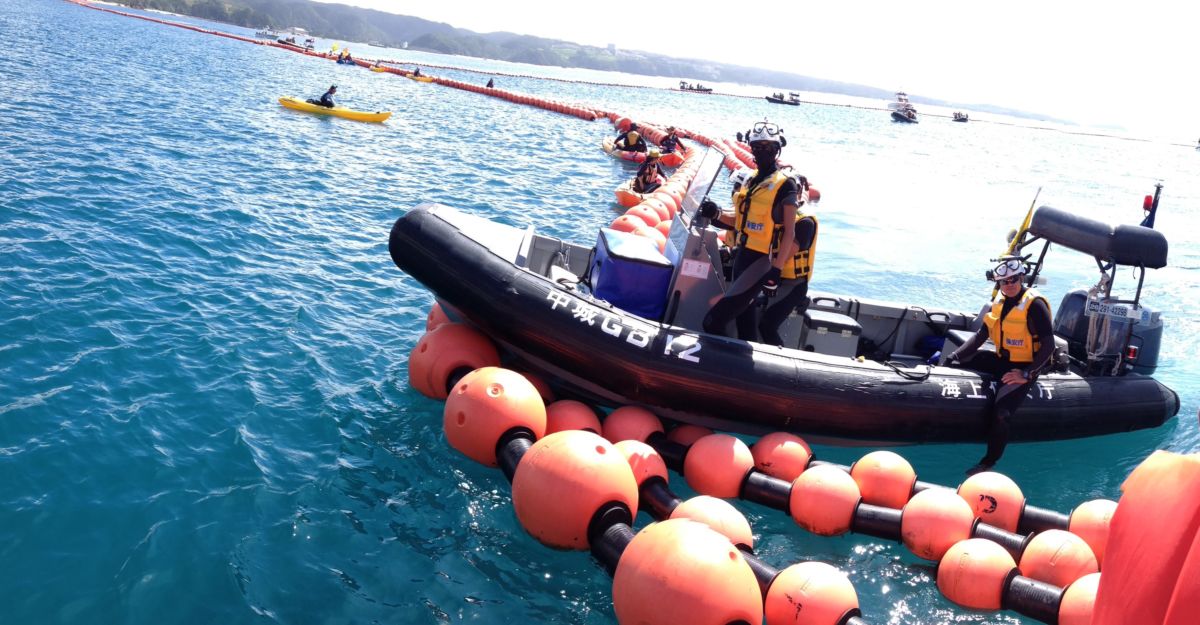Hidden beneath the aquamarine waters off Cape Henoko in northern Okinawa, Oura Bay teems with life. Orange-spotted filefish dart among reefs of blue coral, fantastic Christmas tree worms and tiny translucent invertebrates called sea squirts nestle in colonies of porites corals and redeye gobies flit among forests of stony coral.
Hemmed by white sand beaches, Oura Bay is a hotspot of biodiversity, home to more than 5,300 species of corals, fish, invertebrates and Okinawa’s last remaining population of dugong, an endangered manatee-like marine mammal.
According to a Japanese Ministry of Defense Environmental Impact Assessment, more than 260 endangered species — giant sea cucumbers, snakes and slugs, crabs, sponges and other species still undescribed by science — live in Oura Bay. Surveys document a high level of endemism (species that occur only in a single location), offering the potential for new scientific discoveries.
But Oura Bay and Henoko are also the site of a new U.S. Marine airbase being built alongside the existing Camp Schwab. For decades, Washington and Tokyo have been planning to close the controversial and dangerous Marine Corps Air Station Futenma in the densely populated south of the island and relocate operations to Henoko.
The Futenma Replacement Facility at Henoko, however, has proven to be even more unpopular than the base it’s intended to replace, with a majority of Okinawans consistently rejecting the Henoko plan. Opponents cite noise, danger, and the destruction of fragile marine and terrestrial ecosystems among the chief reasons they are calling for the new base to be built outside Okinawa.
Despite decades of protests, arrests and appeals by Okinawan officials and a growing number of Japanese and foreign supporters, Tokyo and Washington insist the Henoko plan is “the only solution” and have started a massive land reclamation effort in Oura Bay based on a “V”-shaped runway, helipads and fuel docks that would link the new installation to an existing ordnance ammunition depot and other military infrastructure.
Japan’s accomplished record of island building and nature-defying engineering feats is being tapped as Henoko’s reclamation work requires 21 million cubic meters of dirt and sand imported from other parts of Japan be poured into the bay.
An Outsized Burden

Okinawa, formerly the independent Ryukyu Kingdom, has a history and culture distinct from Japan. This southernmost prefecture represents less than 1 percent of Japanese territory, yet it hosts more than half of the 57,000 active duty U.S. military personnel stationed in the country.
Following the bloody battle of Okinawa at the end of World War II, Okinawa was occupied by the U.S. military until its reversion to Japan in 1972. Okinawa continues to bear an outsized burden on behalf of mainland Japan, prompting regular anti-U.S. base protests which erupt anew whenever there is another U.S. military-related accident, crash, violent crime, drunk driving incident or aircraft part falling onto a public space.
In a non-binding referendum held in Okinawa in February, 72 percent of votes were cast in opposition to the Henoko plan. Following the vote, Japanese Prime Minister Shinzo Abe responded by insisting the Henoko plan would go forward.
“Soft as Mayonnaise”

Politics and protests aside, from an engineering standpoint, the Henoko plan is fraught with problems, including a seafloor one Japanese official described as being as “soft as mayonnaise” and unable to support the proposed construction.
Okinawa also has a history of earthquakes, and a recent survey in the area surrounding Henoko strongly suggests the site is on an active fault.
Furthermore, according to the Japanese Defense Ministry, it may take another 44 months to modify the seafloor to the degree that it could structurally support the proposed base expansion.
In 2015, an Okinawan Expert Commission’s preliminary summary of a report appointed by then-Gov. Takeshi Onaga said the U.S.-Japan Status of Forces Agreement (SOFA) would keep requests to respect environmental considerations just that — requests.
Under the U.S.-Japan SOFA, the U.S. military has wide latitude to do as it wants including: “to construct, install, maintain and employ in any facility or area any type of installation, weapon, substance, device, vessel or vehicle on or under the ground, in the air or on or under the water.”
“In the end, no environmental preservation measures have been proposed that could effectively make the US military operate with consideration towards the environment,” the report read.
In 2014, seabed drilling began, and by 2015, giant concrete blocks, reportedly weighing at least 20 tons, were being positioned on the floor of Oura Bay in “dozens of places.”
A March 2018 summary report of a symposium on Henoko-Oura Bay stated that, Japan bears responsibility to preserve the coral reefs of Okinawa. Yet, in February 2019, Japanese media broadcast a television interview with Prime Minister Shinzo Abe falsely claiming corals had been relocated and outside of the construction zone.
In 2014, 19 Japanese conservation organizations collectively recognized the coral reef ecosystem of the Western Pacific as being “home to the highest marine biodiversity around the world.” Individually, however, many scientists in Japan are reluctant to speak out on Henoko, fearing political and professional backlash from taking a position that contrary to the Abe administration’s unwavering support for the Henoko plan.
One marine biologist is not afraid to discuss her findings. Dr. Mariko Abe is chief of the conservation division, nature conservation department of the Nature Conservation Society of Japan, one of the three largest conservation NGOs in Japan. Abe has been conducting extensive coral reef and seagrass bed surveys in Oura Bay since 1998.
Speaking from Okinawa after a coral reef survey in March, Abe told Truthout that one of Oura Bay’s defining characteristic is its complex topography of submarine mountains and valleys — 300 feet deep in places — that support high levels of biodiversity like “very, very rare corals” that can live at depths of 100 feet.
The bay’s depth makes it attractive to the military, Abe said. “This is why military people want to use [Henoko], because they have submarines and big ships. It’s very difficult to go to other places.”
In the summer of 2018, during a two-month suspension of the Henoko landfill permit, Abe and fellow researchers were allowed to conduct surveys within the restricted area which revealed the loss of one species of seagrass and impacts to the bay’s topography resulting from the base’s seawall construction.
“We are now losing our seagrass beds directly because of the construction,” Abe said.
The Dugong Are Gone
Oura Bay’s seagrass beds are habitat for the dugong, explained Dr. Masahito Yoshida, chair of world heritage and cultural studies at the University of Tsukuba.
“Oura Bay is one of the last remaining and northernmost habitats of [the] endangered dugong populations in Okinawa,” Yoshida told Truthout in an email. Until recently, there were thought to be only three animals in waters around Okinawa, but in March, the body of a dead female dugong was discovered in northern Okinawa.
Yoshida added that Oura has unique environments that include “shallow mangrove forests, seagrass beds, and deep waters that are home to blue coral and various benthic (bottom dwelling) species found nowhere else in the world.”
None of this is lost on Giovanni Masucci, a marine biologist and Ph.D. student at the University of the Ryukyus in central Okinawa, where he evaluates the impacts of seawalls, landfills and other construction on Okinawa’s coastal areas. Most of his research focuses on the less-populated far north beyond Oura Bay where access is restricted due to base construction at Henoko.
Masucci told Truthout that Oura Bay’s rare and undescribed diversity “is something noteworthy, important and that should be protected.” Even if mitigation steps are taken, Masucci said Oura Bay has already been impacted.
“Once you [create a] landfill, there are so many impacts. Not just on the area you are landfilling,” Masucci said. “You have a reef being covered by dirt and then by concrete, so of course nothing will survive there. Even beyond the landfill, red soil will spread and there will be consequences.”
With seawall construction underway, Masucci said that where seawater had been contained for months, lower water quality has led to the growth of nutrients, producing seaweed and algae that compete with coral.
As a scientist, he said it’s not his place to say if the base at Henoko should be built or not, but added, “Corals all over the world are facing an unprecedented crisis already due to humans and climate change. So in this context, when we have a biodiversity hotspot, we should think carefully about what happens when we start altering it and really think if there is no alternative solution because sometimes there are other solutions.”
Among the many Okinawans fighting to protect Henoko and Oura Bay is underwater photographer Osamu Makishi, who began investigating the effects of coral bleaching in 2004. Makishi points out that Oura Bay supports not only sea life, but is also an important breeding ground for migratory terns that travel from as far as Australia to lay eggs and feed their young on the rich waters of Oura Bay.
Bird numbers have been declining in recent years, Makishi said, as the shallow waters of Oura Bay are laid with floats and oil fences that divide the waters. He worries about the environmental toll of land reclamation, revetment and additional environmental disturbances.
“Henoko-Oura Bay is a local Okinawan treasure,” Makishi told Truthout. “But the immeasurable natural heritage is also a treasure for the world. Destroying this bay doesn’t only mean losing these 262 endemic and endangered species. It also means losing irreplaceable life.”
Avoiding Responsibility

Despite the central role the U.S. plays in the base at Henoko, the controversy remains scarcely known in the United States.
At the heart of the dispute, the U.S. Marine Corps is effectively silent on the question of its own presence. A spokesman for the Marine Corps Installation Pacific told Truthout, “The [Futenma Replacement Facility] construction project and construction site is managed by the Okinawa Defense Bureau (ODB). It would be inappropriate for us to comment on any construction project details, construction progress, timelines, or plans.”
For its part, the ODB says it cannot comment on the Henoko project, and referred all inquiries to the Japanese Ministry of Defense, which did not respond to multiple requests for comment.
Member of Congress have similarly avoided any responsibility for the Henoko plan. In Hawaii, which shares strong cultural ties and a sister-state relationship with Okinawa, Congresswoman Tulsi Gabbard once said, “Protecting our water … is an issue that is important to all people and living beings everywhere. Water is life … it is essential that we prevent water resources from being polluted in the first place.”
When asked about Henoko in 2016, she insisted it was an internal dispute between Tokyo and Okinawa, and said, “of course the US government is not going to get involved.”
Gabbard did not respond to multiple requests for additional comment.
Also representing Hawaii in Congress, Sen. Mazie Hirono, who was born in Japan, said of U.S. military bases in Okinawa, “It’s not as though we are forcing bases in these places. We are generally asked to come.”
As officials in Washington and Tokyo point fingers at each other, Okinawa Gov. Denny Tamaki, himself the son of a U.S. soldier, is staunchly opposed to the building of a U.S. airbase in Oura Bay and has called for three-way talks to discuss an alternative to Henoko, yet politicians in Japan and the U.S. have long refused to consider anything else.
Ultimately, construction of a new U.S. military installation at Henoko could cost $23 billion, reportedly 10 times the initial estimate. That cost is not shouldered by the United States, but by Japanese taxpayers, and especially by Okinawans who are seeing Oura Bay transformed from a sanctuary for nature and biodiversity into a staging ground for military operations.
Join us in defending the truth before it’s too late
The future of independent journalism is uncertain, and the consequences of losing it are too grave to ignore. To ensure Truthout remains safe, strong, and free, we need to raise $27,000 in the next 24 hours. Every dollar raised goes directly toward the costs of producing news you can trust.
Please give what you can — because by supporting us with a tax-deductible donation, you’re not just preserving a source of news, you’re helping to safeguard what’s left of our democracy.
